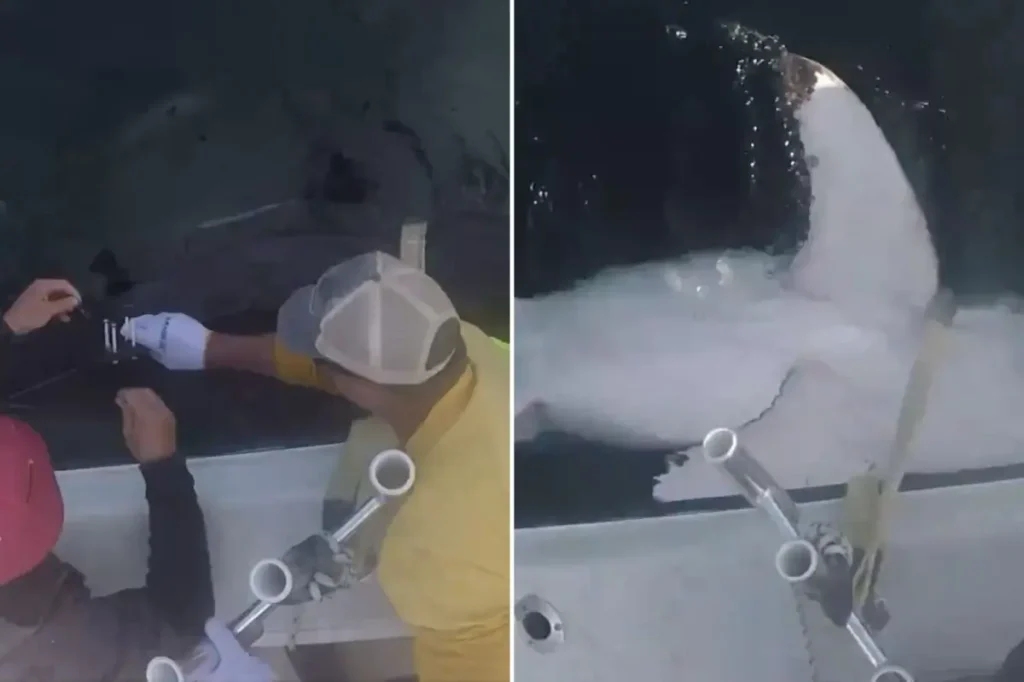The Journey of a Mighty White Shark: Tracking “Quint” Down the East Coast
In a remarkable display of nature’s majesty and modern conservation efforts, a massive white shark named “Quint” was recently tracked off the coast of Beaufort, North Carolina. Standing at an impressive 9 feet, 8 inches, this sub-adult apex predator isn’t just any shark making its seasonal migration—it represents a significant milestone for marine research. Quint earned his special name as the 100th white shark tagged in OCEARCH’s Global Shark Tracker, a feat that symbolizes years of dedicated work to understand these magnificent ocean predators. Like many “snowbirds” seeking escape from the northern cold, Quint began his southward journey from Mahone Bay, Nova Scotia, ultimately pinging off the Carolina Coast on November 14th, providing researchers with valuable data about migration patterns and shark behavior along the Eastern Seaboard.
OCEARCH, the global non-profit organization tracking Quint and his marine brethren, has revolutionized our understanding of marine life through their persistent data collection efforts. Their work goes beyond mere tracking; it represents a comprehensive approach to ocean conservation through scientific research. Each ping from a tagged shark like Quint adds another piece to the complex puzzle of marine ecosystems, helping scientists develop more effective conservation strategies. The organization’s founder and Expedition Leader, Chris Fisher, expressed both pride and astonishment at reaching the 100-shark milestone, saying, “When we started, not one white shark had been tagged in the Western North Atlantic by OCEARCH—and tagging 100 felt impossible. But inch by inch, with grit, teamwork, and belief, we got there.” This achievement reflects not only technological advancement but also the unwavering dedication of researchers committed to protecting our oceans.
The naming of this landmark shark carries special significance within the scientific community. “Quint” bears his name in honor of Dr. Quinton White from Jacksonville University’s Marine Science Research Institute, recognizing the vital role academic institutions play in advancing marine conservation. This connection between field research and academic study exemplifies the collaborative nature of modern conservation efforts. By bridging various scientific disciplines and research methodologies, organizations like OCEARCH and institutions like Jacksonville University create a more comprehensive understanding of marine life. The relationship between tagged sharks and the scientists who study them forms the backbone of marine conservation, with each named shark becoming an ambassador for its species, helping to replace fear with fascination and respect among the public.
What makes Quint’s journey particularly fascinating is how it reflects the natural behaviors of white sharks along the Atlantic coast. His southward migration mirrors patterns observed in other tagged sharks, who routinely travel thousands of miles annually between feeding and possibly breeding grounds. These migrations aren’t random wanderings but appear to follow ancient routes that have likely been used by sharks for countless generations. By tracking these patterns, scientists gain insights into how environmental factors, including changing ocean temperatures, affect shark behavior. Quint’s movement down the coast represents a natural phenomenon that has occurred for millennia, yet we’re only now beginning to fully document and understand it through the technological capabilities of satellite tracking and the dedicated efforts of marine biologists and conservationists.
Quint’s appearance off North Carolina comes at an interesting moment for shark research, arriving just days after another notable shark made headlines. “Contender,” currently the largest male great white shark in OCEARCH’s database, recently resurfaced off the New Jersey coast. This behemoth measures 13 feet in length and weighs an astonishing 1,653 pounds, with researchers estimating his age at approximately 32 years. The simultaneous tracking of these two impressive predators—Quint in the south and Contender in the north—demonstrates the wide range and diverse behaviors of white sharks in the Western Atlantic. Their movements provide real-time data that helps scientists develop a more nuanced understanding of how different sharks of varying ages, sizes, and possibly social status utilize the ocean’s vast resources.
The ongoing monitoring of sharks like Quint and Contender represents far more than scientific curiosity—it embodies a fundamental shift in how we approach marine conservation. Through the stories of individual sharks, OCEARCH and similar organizations transform abstract conservation concepts into tangible narratives that resonate with the public. Each ping from Quint’s tag not only advances scientific knowledge but also helps build public support for protecting these often misunderstood predators. As climate change and human activities continue to impact marine ecosystems, the data collected from these tagged sharks becomes increasingly valuable for developing effective conservation strategies. The journey of Quint—from his tagging in Nova Scotia to his appearance off the Carolina coast—symbolizes both the natural wonder of shark migration and humanity’s growing commitment to understanding and preserving the ocean’s most iconic inhabitants for generations to come.








